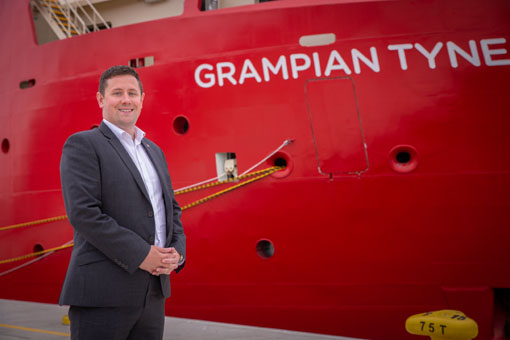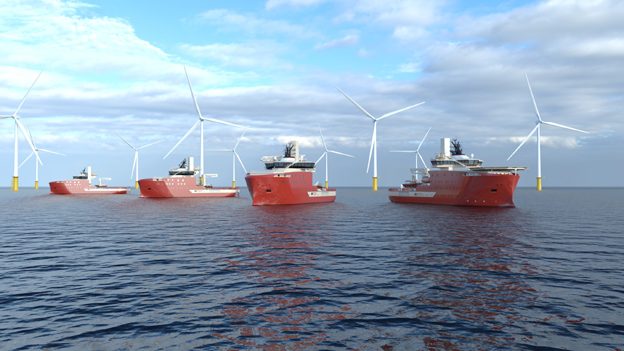
North Star CFO Fraser Dobbie
With the company’s first two chartered offshore wind fleet newbuilds delivered three months early this summer, and four more of its hybrid-electric ships currently under construction, Fraser Dobbie, chief financial officer at North Star - the UK’s leading walk-to-work ship operator - shares how to ensure you literally don’t miss the boat.
With numerous windfarm developments across Europe either in the ether or about to become fully operational, the incremental demand for high quality, low carbon support vessels is gathering pace.
For wind farm operators, choosing an experienced and financially robust walk-to-work vessel operator to provide state-of-the-art tonnage as an infield home and workspace for their wind technicians remains key. These ships deliver offshore wind logistics hubs, a core function widely recognised as the most important asset in the field. They provide a safe haven for technicians to live on, and a well-equipped base to work from during a windfarm’s initial construction phase, and also the subsequent schedule of operations and maintenance campaigns to keep it running safely without interruption.
However, with no clear end in sight to the current maelstrom of global economic volatility, how to finance a new ship build is a conundrum for many vessel operators looking to expand their fleets. Rising interest rates, cost inflation, geopolitical uncertainty and currency fluctuations have recently converged to create uncertainty around the availability and cost of project finance for newbuilding projects during tender processes.

For example, the increase in interest rates over the past 12 months at around 5% has had a significant impact on vessel owners’ debt service costs, having the dual effect of escalating borrowing costs, and reducing the proportion of the project that can be debt financed due to the impact of these costs on project cash flows. This results in accelerating the equity funding burden for vessel owners looking to expand their fleet. Shipbuilding is a capital-intensive business, and even small changes to the availability and cost of debt quickly have a material impact.
As commissioning service operation vessels (CSOVs), with large cabin and warehousing space, and smaller, more client and project bespoke SOVs are the primary means for getting technicians on and off of turbines, windfarm operators are keen to avoid anything which will expose them to the risk of a late delivery, especially as these ships take around three years on average to build. If a tender process fails due to the chosen C/SOV provider no longer being able to finance the required vessel construction against the agreed charter rate, the result would be some very difficult conversations between windfarm operator and potential vessel owner, as well as exposing the windfarm to significant operation risk, having not secured an effective means of maintaining turbines from the required date. No one wants to be exposed to ransom with a more expensive build and charter cost to ensure that they meet deadlines. The alternative for the windfarm firm is going back to the drawing board, awarding the work to another walk-to-work operator and taking the expected delays and impact on their shareholders squarely on the chin.
With the number of C/SOV tenders expected to grow exponentially as the energy transition continues, a company’s ability to unlock the huge amounts of funding required to support the construction of multiple ship builds for on-time delivery will prove absolutely crucial. It is an area our business immediately nailed down to support ongoing growth and further expansion as we entered the renewables sector. Only with fully secured debt and equity funding can you have any confidence that there is no disconnect between what is offered in a proposal and what the reality is on winning the bid.
Ensuring credibility with lenders and financial institutions to gain trust of course can be the challenge to adopting this more established and welcomed business model. To secure debt, organisations require a proven track record which will clearly demonstrate their ability to scale up and deliver simultaneous vessel builds within budget and on schedule. They also need the expertise in-house to project manage campaigns to be efficient in terms of marine operations and reliability of service, which is key for any client offshore.
North Star’s 135-year longevity, including four decades of providing around the clock, 365-days-a-year critical emergency response support in the UKCS, played an important role in attracting the backing of Partners Group, a leading global private markets firm with $135 billion in assets under management, which acquired North Star in 2022 on behalf of its clients. We also raised a significant and scalable debt package which will allow us to effectively progress all new ship build contracts we secure with immediate effect.
After all, what’s more appealing, going with a prospect which has the financing and flexibility in place, or trusting a vessel operator that needs time to make the sums stack up.
KeyFacts Renewable Energy Directory: North Star
 KEYFACT Energy
KEYFACT Energy